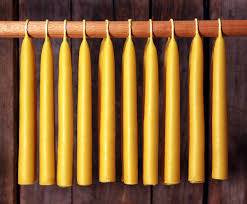The guild title “chandler” refers to someone who makes or directs the manufacture of candles, soaps and other consumable goods such as lye, saltpeter, gunpowder, and other chemicals.
Candles were made by either dipping a wick in molten wax or pouring that wax into a mold around the wick. By the late 1700s, many of the candles used in the American colonies were produced by commercial chandlers.
Soap is a natural by-product of candle making, so many chandleries also sold soap. To make soap, a ready supply of potash or lye is required so the manufacture of lye soon became a critical part of each chandlery and since the process for making lye and making saltpeter, a key ingredient in gunpowder, is basically the same, these products were soon added to the chandler’s portfolio of products.
As both candles, gunpowder, and soap were typical supplies for seagoing vessels, many chandleries in the American Colonies expanded to be general outfitters of ships.
There are three basic strategies for creating candles:
· Dipping: A large pot of wax (or tallow) is heated to just above the melting point — if the wax is too hot, the candles will just remelt when dipped – then a wick of cotton or hemp wick (often prewetted with wax) is dipped in the hot wax, withdrawn and allowed to harden, then dipped again. We repeat this process until a nice fat taper is formed.
· Pouring: Like dipping, wax is heated in a pot only instead of dipping the wick in the wax, hot wax is poured down the length of the wick. Using this technique, it is possible to make very long thin candles but it is difficult to make these candles as uniform and symmetrical as the dipped candles.
· Votive: This is a popular format for modern candle hobbyist. A wick is secured vertically in a heat resistant vessel like a glass or small pot. Wax is poured around the wick and the entire assembly is used as a candle. Votive candles are particularly useful in lanterns as they last a very long time. Tallow votives also do not drip because they are contained so if your tallow is of low quality, creating votives is a great option. Finally, there is
· Molding: Commercial chandlers or very wealthy households often had purpose-built candle molds. These create uniform pillars in a form very similar to modern candles. The only drawback to candle molds is the expense of the molds. Since these must fully cool before the candles can be extracted, a chandler would need quite a few of these tin molds and that can represent a significant investment.
Popular types of Candles:
Tallow was a popular, AND CHEAP, way to make every day candles. Meat drippings and scrap fats are rendered to make a solid fatty wax that forms the body and fuel of the candle. Rendering, literally ripping apart, of the fats is accomplished by heating the bulk fat until it boils. Candles made from pure tallow are smelly and drip easily. On hot days they even begin to melt at room temperature and may bend or sag.
The best candles are, of course, made from just the natural waxes like beeswax or bayberry. Beeswax comes from honeycombs so getting a good supply of this wax is very difficult. Only very special candles are made of beeswax.
Bayberry grows abundantly in New England and is easily harvested in the fall and rendered like fat. Collecting enough bayberry for a year’s worth of candles is a lot of work but certainly doable. Rendering bayberry yields a hard vegetable wax with a high melting point and a pleasing aroma when burned. Bayberry wax turns a wonderful soft green color when boiled in a copper pot (oxidation of the copper ions).
Other Products:
In addition to Candles, the Chandler often made soap. Most households in Colonial America made their own soap but, in the cities, there was often a consolidation of labor and chandlers made soap in addition to candles.
Soap is made from the same left-over fats and oils from which me make candles., especially tallow. The only difference is that rather than molding these fats and waxes into candles we first saponify the fat by mixing it with lye.
Chandlers often made their own lye collecting ashes from area homes and percolating water through them to leach out the lye (KOH) . Using a similar process, chandlers would create Saltpeter (KNO3) from night soil and manufactured various other industrial chemicals.
It is the production of these chemicals that resulted in Chandlers often being associated with ships quartermasters and the supply of goods to ships and the sale of general merchandise.

